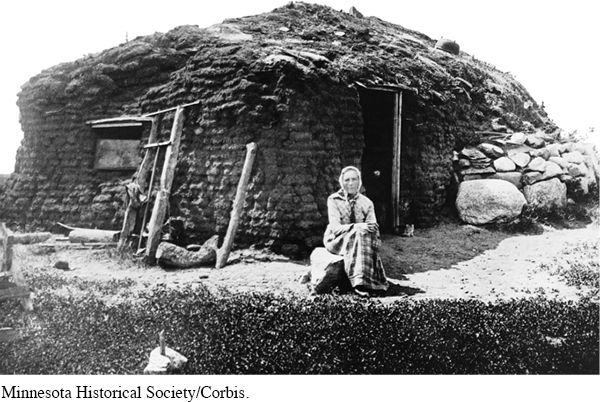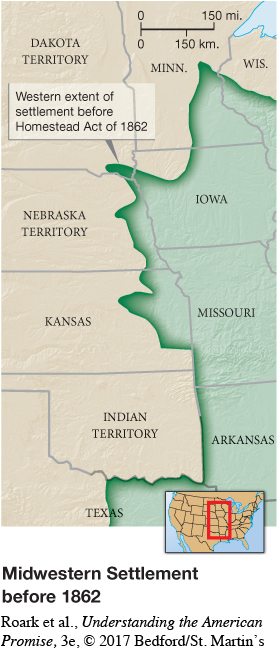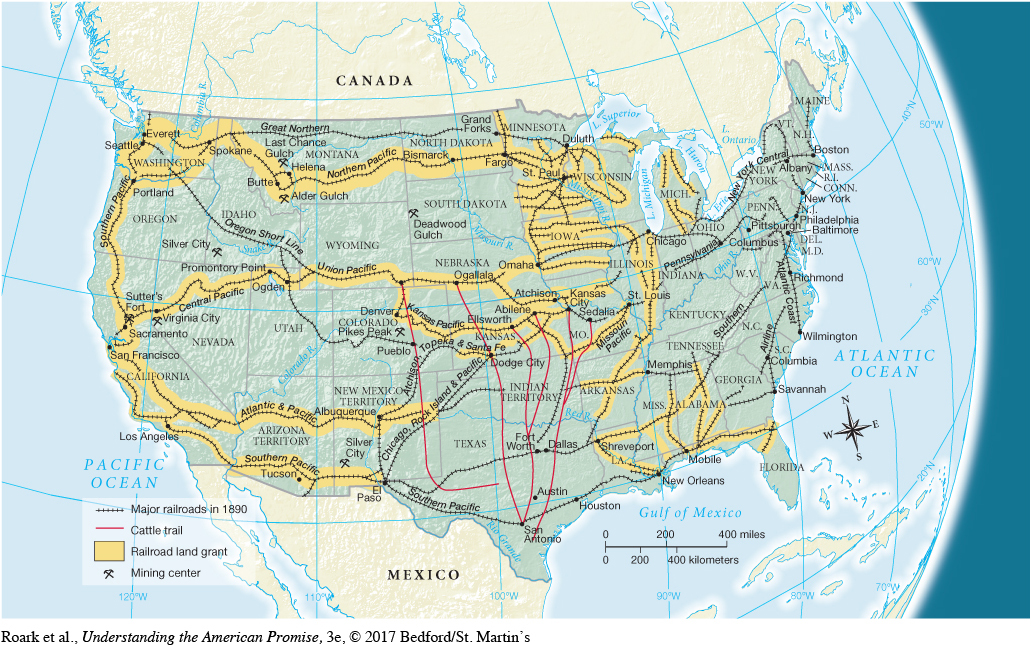Moving West: Homesteaders and Speculators
A Missouri homesteader remembered packing as her family pulled up stakes and headed west to Oklahoma in 1890. “We were going to God’s Country,” she wrote. “You had to work hard on that rocky country in Missouri. I was glad to be leaving it. . . . We were going to a new land and get rich.”
Settlers who headed west in search of “God’s Country” faced hardship, loneliness, and deprivation. To carve a farm from the raw prairie of Iowa, the plains of Nebraska, or the forests of the Pacific Northwest took more than fortitude and backbreaking toil. It took luck. Blizzards, tornadoes, grasshoppers, hailstorms, drought, prairie fires, accidental death, and disease were only a few of the catastrophes that could befall even the best farmer. Homesteaders on free land still needed as much as $1,000 for a house, a team of farm animals, a well, fencing, and seed. Poor farmers called “sodbusters” did without even these basics, living in houses made from sod (blocks of grass-covered earth) or dugouts carved into hillsides and using muscle instead of machinery. [[LP Photo: 17.11 Norwegian Immigrant and Sod House – VISUAL ACTIVITY/

“Father made a dugout and covered it with willows and grass,” one Kansas girl recounted. When it rained, the dugout flooded, and “we carried the water out in buckets, then waded around in the mud until it dried.” Rain wasn’t the only problem. “Sometimes the bull snakes would get in the roof and now and then one would lose his hold and fall down on the bed. . . . Mother would grab the hoe . . . and after the fight was over Mr. Bull Snake was dragged outside.”

For women on the frontier, obtaining simple daily necessities such as water and fuel meant backbreaking labor. Out on the plains, where water was scarce, women often had to trudge to the nearest creek or spring. “A yoke was made to place across [Mother’s] shoulders, so as to carry at each end a bucket of water,” one daughter recollected, “and then water was brought a half mile from spring to house.” Gathering fuel was another heavy chore. Without ready sources of coal or firewood, the most prevalent fuel was “chips”—chunks of dried cattle and buffalo dung, found in abundance on the plains. [[LP Spot Map: SM17.02 Midwestern Settlement Before 1862/
Despite the hardships, some homesteaders succeeded in building comfortable lives. The dugout made way for the sod hut—a more substantial dwelling; the log cabin yielded to a white clapboard home with a porch and a rocking chair. For others, the promise of the West failed to materialize. Already by the 1870s, much of the best land had been taken. Too often, homesteaders found that only the least desirable tracts were left—poor land, far from markets, transportation, and society. “There is plenty of land for sale in California,” one migrant complained in 1870, but “the majority of the available lands are held by speculators, at prices far beyond the reach of a poor man.” The railroads, flush from land grants provided by the state and federal governments, owned huge swaths of land in the West and actively recruited buyers. Altogether, the land grants totaled approximately 180 million acres—an area almost one-tenth the size of the United States (Map 17.3). The vast majority of farmland sold for a profit. [[LP Map: M17.03 Federal Land Grants to Railroads and the Development of the West, 1850–1900 – MAP ACTIVITY/

As land grew scarce on the prairie in the 1870s, farmers began to push farther west, moving into western Kansas, Nebraska, and eastern Colorado—the region called the Great American Desert by settlers who had passed over it on their way to California and Oregon. Many agricultural experts warned that the semiarid land (where less than twenty inches of rain fell annually) would not support a farm on the 160 acres allotted to homesteaders. But their words of caution were drowned out by the extravagant claims of western promoters, many employed by the railroads to sell off land grants. “Rain follows the plow” became the slogan of western boosters, who insisted that cultivation would alter the climate of the region and bring more rainfall. Instead, drought followed the plow. Droughts were a cyclical fact of life on the Great Plains. Plowed up, the dry topsoil blew away in the wind. A period of relatively good rainfall in the early 1880s encouraged farming; then a protracted drought in the late 1880s and early 1890s forced thousands of starving farmers to leave, some in wagons carrying the slogan “In God we trusted, in Kansas we busted.”
Fever for fertile land set off a series of spectacular land runs in Oklahoma. When two million acres of land in former Indian Territory opened for settlement in 1889, thousands of homesteaders massed on the border. At the opening pistol shot, “with a shout and a yell the swift riders shot out, then followed the light buggies or wagons,” a reporter wrote. “Above all, a great cloud of dust hover[ed] like smoke over a battlefield.” By nightfall, Oklahoma boasted two tent cities with more than ten thousand residents. In the last frenzied land rush on Oklahoma’s Cherokee strip in 1893, several settlers were killed in the stampede, and nervous men guarded their claims with rifles. As public land grew scarce, the hunger for land grew fiercer for both farmers and ranchers.
Barbed wire, invented in 1874, revolutionized the cattle business and sounded the death knell for the open range. As the largest ranches in Texas began to fence, nasty fights broke out between big ranchers and “fence cutters,” who resented the end of the open range. One old-timer observed, “Those persons, Mexicans and Americans, without land but who had cattle were put out of business by fencing.” Fencing forced small-time ranchers who owned land but could not afford to buy barbed wire or sink wells to sell out for the best price they could get. The displaced ranchers, many of them Mexicans, ended up as wageworkers on the huge spreads owned by Anglos or by European syndicates.
On the range, the cowboy gave way to the cattle king and, like the miner, became a wage laborer. Many cowboys were African Americans (as many as five thousand in Texas alone). Writers of western literature chose to ignore the presence of black cowboys like Deadwood Dick (Nat Love), who was portrayed as a white man in the dime novels of the era.
By 1886, cattle overcrowded the range. Severe blizzards during the winter of 1886–87 decimated the herds. “A whole generation of cowmen,” wrote one chronicler, “went dead broke.” Fencing worsened the situation. During blizzards, cattle stayed alive by keeping on the move. But when they ran up against barbed wire fences, they froze to death. In the aftermath of the “Great Die Up,” new labor-intensive forms of cattle ranching replaced the open-range model.
Understanding the American Promise 3ePrinted Page 488
Section Chronology